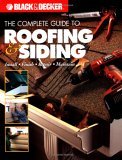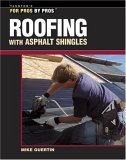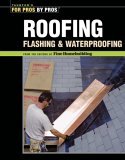A Guide to Installing Asphalt Roofing Shingles
By Mark J. Donovan
|
|
Asphalt roof shingles are the most common type of roof shingles used on homes today. Asphalt roof shingles come in two basic styles, 3-tab shingles and architectural shingles. 3-tab asphalt roof shingles are less expensive than architectural shingles, but typically do not last as long and are less aesthetically attractive. Asphalt roof shingle installation should typically be left to the professionals as working on a roof is dangerous and installing asphalt roofing shingles correctly is imperative for a leak free roof.
This said, on a simple 2 plane low pitched roof, an asphalt roof shingle installation project should be able to be performed by a handy and brawny diy homeowner. |
Prior to asphalt roof shingle installation the roof sheathing should be inspected for any damage. If there are damaged or rotting roof sheathing pieces they should be replaced before installing the new asphalt roofing shingles.
Drip edge should then be installed on the roof followed by one or two courses of Ice and Water shield. The Ice and Water shield should be installed along the roof eaves, near any adjacent walls to the roof, and in roof valleys.
Next install roof felt paper over the entire roof surface. Staple the roof paper down to the roof sheathing.
| To ensure a proper asphalt roof shingle installation, use a chalk line to establish straight and true lines up the length of the roof line. To determine the frequency of chalk lines measure the exposed reveal on the shingles. Typically shingle reveal is about 5 inches. Consequently, every 5 inches establish a chalk line.
Then install metal flashing around chimneys and any wall edges that abut the roof line. With a basic roof consisting simply of two planes, such as is the case in a ranch or colonial home, asphalt roof shingle installation begins with applying a row of starter shingles near the roof eaves. |
 |
Starter shingles are necessary for preventing water from working its way through to the roof sheathing between the gaps and notches in the first row of shingles. You can either use pre-fab’d starter asphalt roof shingles or you can create your own by simply cutting away the tabs on standard 3-tab shingles. Position the outside edge of the starter strip shingles ¼ to ¾ inch beyond the roof eave and drip edge, to prevent fascia board rot.
| Once the row of starter shingles have been installed, you can begin the main asphalt roof shingle installation task. Start installing roof shingles at the lower corner on one side of a roof plane. For example, start on the far lower left of the roof plane. Install singles in a stair like pattern working your way to the right and up. Make sure when installing the shingles that the course just above the lower course are placed so that the shingle ends and the tab notches do not line up with the lower course row of shingles. Otherwise you’ll end up with a leaky roof. |  |
Also, when installing the first row of shingles make sure the edge of them hang approximately 1/8” over the starter shingle row and roof edge. By doing this you can prevent water from running off the roof and down the fascia board. Regular dripping of water on the fascia board can cause it to rot in short order.
Plastic roof ridge vent should then be installed over the length of the ridge vent using long roofing nails.
Finally, nail ridge cap asphalt roof shingles down over the ridge vent. Make sure the ridge cap shingles overlap each other with the same reveal as the main asphalt roof shingles. Also, on the first ridge cap shingle tack it down with a few dabs of roofing tar.
Final Note: Asphalt roof shingle installation is extremely heavy and dangerous work. Make sure to use sturdy ladders, and roof jacks on higher pitched roofs. Also, have one or two helpers to aid in hauling shingles up on the roof and installing the roof shingles. In addition, always wear a good pair of rubber-soled shoes for solid traction when working on the roof. Finally never install asphalt roof shingles on a wet or cold roof.
For more help on Shingling Your Home’s Roof, see HomeAdditionPlus.com’s Asphalt Shingle Roofing Bid Sheet. The Asphalt Shingle Roofing Bid Sheet will help to ensure that your roof won’t end up with a blue tarp over it and a dumpster sitting in your yard for weeks as you wait for the roofing contractor to come back and finish roofing your home.
Asphalt Shingle Roofing Cost Estimator
Related Roofing Information
Additional Roofing Resources from Amazon.com
 |
 |
 |
 |
Roofing Price Quotes For FREE, No Obligation!
Fill out our 3-5 minute quick and easy form, and receive a free price quote on roofing from one of our prescreened and licensed roofing contractors. This process is free and there is no obligation to continue once you receive your roofing price estimate.

